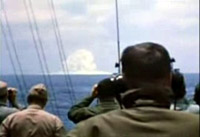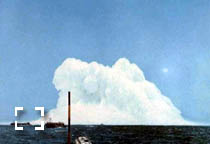 |
|
Operation Wigwam - 1955
 Operation Wigwam consisted of a single nuclear detonation, (both the operation and test are known as Wigwam), conducted 800 kilometers SW off San Diego, California. It was a deep water test (the ocean is 4,877 meters deep at that point) to investigate the vulnerability of submarines to deep nuclear weapons, and the feasibility of using depth bombs in combat.
Operation Wigwam consisted of a single nuclear detonation, (both the operation and test are known as Wigwam), conducted 800 kilometers SW off San Diego, California. It was a deep water test (the ocean is 4,877 meters deep at that point) to investigate the vulnerability of submarines to deep nuclear weapons, and the feasibility of using depth bombs in combat.
Wigwam tested the principles of the previously cancelled third deepwater shot codenamed Charlie, originally scheduled for the spring of 1947 during Operation Crossroads. 30 ships and 6544 personnel participated in Wigwam under the command of Joint Task Force Seven.
The Navy was interested in learning how such a deep underwater shot would affect naval forces. The main questions were regarding lethality ranges, the effects of the radioactivity following the explosion, and safe deployment distances.
The 30kt warhead used in the test was a W-7 variable-yield fission weapon, using a levitated pit and a 92 high-explosive lens implosion assembly. The caison containing the weapon was suspended by a 610 meter cable from a towed unmanned barge. A 9.6 kilometer tow-line connected the fleet tug, Tawasa and the shot barge. Suspended from this line at varying ditances from the barge were three 'Squaws' - 4/5ths scale submarine-like pressure hulls equipped with instruments and cameras.
Original plans to use actual submarines were rejected to simplify the test results and to save costs. The Squaws were supported underwater by eight 80 ton submarine salvage pontoons. The target Squaws were to be placed at distances of 1,600, 2,130 and 3,000 meters from surface zero. These distances were revised on shot day, which was delayed by three days due to poor weather.
The ships conducting the test were 8 kilometers upwind from the barge, with the exception of the USS George Eastman (YAG-39) and USS Granville S. Hall (YAG-40). These two ships were equipped with heavy shielding and were stationed 8 kilometers downwind. Both ships were contaminated by the base surge, but due to the relatively dilute radioactivity (since the shot was at such a great depth) and the heavy shielding kept exposures within the Operation Wigwam dose limit of 3.9 rems.

Wigwam - 14/05/1955
|
The device was detonated at 1:00 P.M. Pacific Daylight Time on May 14, 1955.
Wigwam resulted in three sources of radiological contamination: airborne activity, residual fallout and water contamination. During the first three seconds after the detonation, the radioactive debris was primarily contained within an initial bubble formed by the interaction of thermal energy with the water. Then, beginning at approximately
H + 10 seconds these gaseous products began to reach the water surface, forming spikes and plumes reaching maximum heights of 270 to 440 meters and emerging from an area roughly 940 meters in diameter.
As these plumes fell back into the water, a large cloud of mist was formed. At H + 90 seconds, this base surge had radius of 1,400 meters and a height of 580 meters. At H + 13 minutes, a foam ring appeared with a 3,200 meter diameter. The area within this ring probably approximated the extent of the contaminated water. While the surface water initially showed significant contamination levels, the water dispersed and radiation decayed rapidly, so that by May 18 the maximum radiation reading found over an 200 square kilometer area was on the order of one milliroentgen per hour (mR/hr) at 1 meter above the surface.
Underwater Sound
The underwater sound from the Wigwam explosion was recorded on bottom-mounted hydrophones at Point Sur and Point Arena off California, and Hawaii. The sound from the explosion began as an intense water shock wave. As the sound traveled away from the test point, it reflected from topographic features, such as islands and seamounts, located throughout both the North and South Pacific Basins. Some of the acoustic energy travelled round trip distances of over 20,000 km.
Conclusion
The Wigwam test showed that if deep underwater bursts are employed in wartime situations, it is possible for significant doses to be received from airborne activity by exposed personnel directly downwind of surface zero and within a few miles of it. This existing only during passage of the base surge or fallout cloud. As such the operational weapon was usually delivered by aircraft. The test device was deployed in a task specific casing as the Mark 90 nuclear depth charge given the nickname 'Betty'. A total of about 225 were produced, with all units being retired by 1960.
|

| - DNA 6000F - Defense Nuclear Agency report - Wigwam
|
|
|
 |



 Operation Wigwam consisted of a single nuclear detonation, (both the operation and test are known as Wigwam), conducted 800 kilometers SW off San Diego, California. It was a deep water test (the ocean is 4,877 meters deep at that point) to investigate the vulnerability of submarines to deep nuclear weapons, and the feasibility of using depth bombs in combat.
Operation Wigwam consisted of a single nuclear detonation, (both the operation and test are known as Wigwam), conducted 800 kilometers SW off San Diego, California. It was a deep water test (the ocean is 4,877 meters deep at that point) to investigate the vulnerability of submarines to deep nuclear weapons, and the feasibility of using depth bombs in combat.



